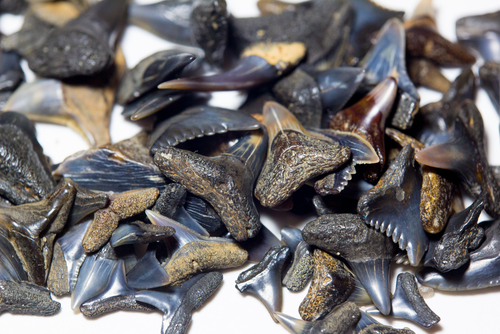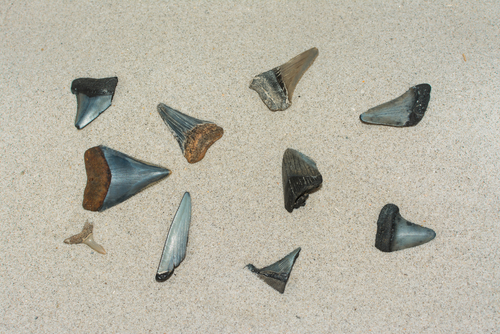A Fun Adventure For The Whole Family: How to Find Shark Teeth in Creeks and Rivers?
On your next trip to the river, there’s a fun, and maybe even a profitable adventure that you can have. You can dig up black gold! True, shark teeth are no match for the true black gold, aka petroleum. Still, it’ll be a fun adventure that brings up the paleontologist in you!
Besides, isn’t it cool to hold in your hands the remains of creatures that populated the earth millions of years ago? At least you get to know what the fuss Ross was making is about.
Let’s move on and know how to find shark teeth in creeks and rivers!
Why Creeks and Rivers Are the Best Places for Finding Shark Teeth
Layers of sand and rocks are reservoirs for all kinds of fossils. Casual seekers for these buried remains usually don’t excavate. Aside from the required equipment for that, there are some legal issues that we’re going to get to later.
Instead, recreational diggers stick to the superficial, exposed layers. These are known as sedimentary layers. The fossils residing in these layers are attainable because they’re vulnerable to the elements. Exposed by the tide and the wind, you can put your hands on shark teeth by minimal digging.
In creeks and rivers, the low tide helps with this process of eroding and exposing sedimentary layers. Besides being superficial, these teeth are exceptionally abundant there.

Why Are Shark Teeth Extremely Abundant on Riverbanks and Beaches?
See, these mighty sharks like to keep their spears honed at all times. Therefore, they shed their teeth continuously to keep them sharp whenever needed.
They grow a new set of teeth as frequently as every week! Moreover, some paleontologists have put forth evidence that they shed teeth while still in the womb! These sharks are something, aren’t they?
You might be wondering: where does this peculiarity stop? I mean, if I can find their teeth this readily, can I stumble on more than just teeth?
Can I Find Other Shark Remains Along With the Teeth?
That’s not likely. Teeth are exceedingly more easy to find than other body parts. For one thing, teeth are made of something called dentin. Dentin is harder than bone, which helps the teeth survive all the eroding they’re subjected to.
Another reason is that, unlike other parts, the teeth become mineralized. Thus, they form a tough fossil, in a process called fossilization. Why don’t other parts of the shark fossilize? That’s because most of its body is made of cartilage. Unlike bone and dentin, cartilage doesn’t fossilize.

What Are the Steps That I Should Follow to Find Shark Teeth?
The first step is to locate the best spot. In that regard, the Peace River in Florida is a go-to. It’s not only abundant in shark teeth, but you’ll also find all kinds of fossils there. However, there’s a catch. Being abundant, you don’t need a permit to look for shark teeth. The same can’t be said for other finds.
To be able to dig as you please and get the full scope of the fossils, you need a Florida fossil permit. No worries, anyone can get this permit through a few simple steps. Besides the Peace River, other rivers rich in shark teeth include:
- The Cooper River in South Carolina
- Saint Johns River in Florida
- Virginia’s Rivers
Now that we know where to find shark teeth, let’s know when.
Read More:
What’s the Best Time to Find Shark Teeth?
The ideal time can come about either by nature or by man. Whichever occurs, you should be there to seize the opportunity. Your first chance is when there’s river dredging going on. Dredging is the scooping out of sediment from the bottom of rivers, lakes, and oceans.
Dredging presents a great opportunity to hunt for shark teeth because of all the fossils that resurface then. Another process on the heels of which you can find a lot of shark teeth is beach nourishment. This process involves adding sediment to replace the ones that eroded.
Regarding natural occurrences that serve your search of shark teeth, storms are your friends. An area that’s particularly common for finding teeth after a storm is sandbars. Low tide, like the one in rivers, will also help expose buried teeth.
How Can I Identify Shark Teeth?
As long as the shape goes, they’re triangular with a wide base and an apex that varies in sharpness. Sometimes, it’ll be serrated as well. Teeth may also be curved in a particular direction that’s dependent upon where it was positioned in the mouth.
Regarding the color, most of the teeth will be black, as they’re fossilized. It’s rare for you to find a white, recent tooth.
To find shark teeth, strolling and glancing around with your naked eye may make the cut. However, if you want to search effectively, and, why not, stumble on an $800 megalodon tooth—then you’re going to need some equipment.
What Equipment Will I Need to Find Shark Teeth?
One tool that can be most effective in hunting shark teeth is the Exact Design sand flea rake. While originally intended for catching sand fleas, this rake can serve you well in your shark teeth pursuit.
First off, the Exact design rake has sharp metal teeth that’ll allow you to dig deep into the sand. You’re going to use teeth to find teeth, isn’t that funny? Anyway, the rake also features a 16-inches wide basket. Thus, you can scoop up large quantities every time you pull the rake out of the sand.
Besides effectiveness, the Exact Design rake is convenient. That’s as it features a curved handle with which you’re going to exert minimal effort digging up fossils. Also, your grip will never slip, thanks to the thick, padded handle.
While the Exact Design rake will do just fine, there’s an alternative to it.
Isn’t There a Tool Specifically Made for Catching Shark Teeth?
Another tool that’s going to help you comb the sand is the shark tooth sifter. Hence the name, it’s a sifter specifically made for catching shark teeth. For that purpose, the sifter has a large basket and a wide area for sifting.
The shark tooth sifter is available in three different sizes: 7 inches, 10 inches, and 12 inches.
Final Words
Many times, we tread lands housing treasure troves of fossils without knowing. When talking about rivers and creeks, especially in Florida, we’re almost always guaranteed to be stepping on such lands.
One particular fossil that can be easily dug up is the shark tooth. These teeth are so abundant that you can hunt for them without a permit. Mostly, you’ll find the usual small, black shark teeth. However, you may hit the jackpot and find a megalodon tooth that’s worth a lot.
There are also tools, like the Exact Desing rake and the shark tooth sifter, that can greatly help you with your quest. What are you waiting for? Fossil hunting has never been easier!
- 7 Of The Largest Gold Nuggets Ever Found…Ever! - December 21, 2023
- Find Gold On Your Property? Here’s Why You Should Think Twice Before Spreading the News - December 21, 2023
- The Opalized Crab Claw (And How It Formed) - September 14, 2023
- Online rock and mineral club for collectors of all levels!
- Find community with like-minded rock and mineral enthusiasts.
- Monthly Giveaways!
- Free Access to Entire Digital Library of Products (current and future products)*



